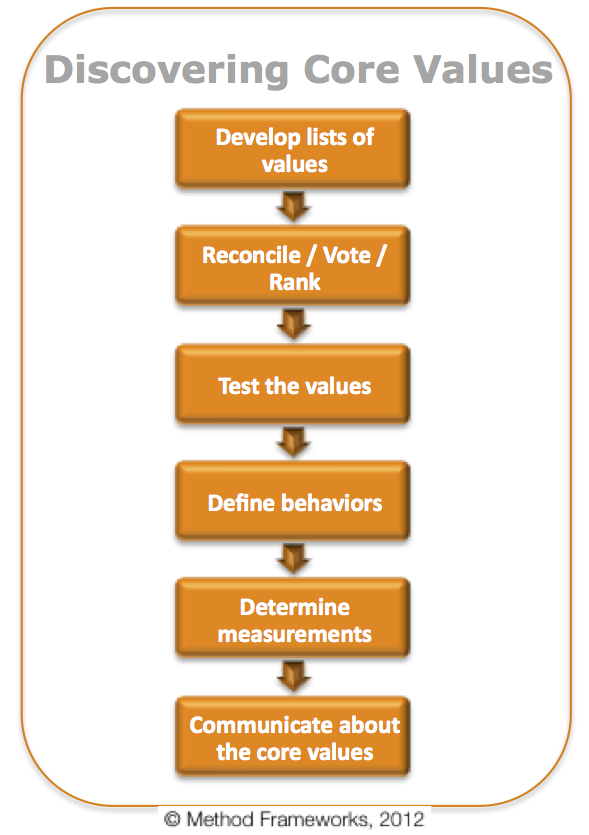Organizational Culture & Values
Six Things CEOs Should Know About Corporate Core Values

Organizational core values are a primary determinant of culture, employee satisfaction and business performance. This article addresses six core value topics that CEOs and business executives should know about.
The Six Topics
- Core values are the building blocks of organizational culture.
- The process of defining, measuring, and improving core values can be an excellent vehicle for improving organizational culture.
- Core values provide a common language to address unacceptable behaviors in a less threatening way.
- Core values guide decisions and emphasize what is important to the business as the organization continues to change and improve.
- Core values influence business performance.
- If core values have not yet been established, a step-by-step process described in this article can be followed to discover them.
1. Core values are the building blocks of organizational culture
The core values of an organization are the foundation of the corporate culture.
Organizational core values do more than just promote ethical business practices. The system of core values that a business owns will shape the culture of the enterprise, the decision-making criteria of your managers and the actions of your employees. The more strongly defined the organization’s core values, the more likely that this value system will serve as a code of conduct that promotes and guides strategically-aligned behaviors within managers and employees.
2. The process of defining, measuring, and improving core values can be an excellent vehicle for improving organizational culture
There are many benefits to be realized by utilizing core values to drive cultural change, but perhaps the following are most significant:
– The process defines a shared set of beliefs and commitments to the way the employees of a business want to behave and treat each other
– The process guides decisions and emphasizes what’s important to the business as plans are developed to change and improve the organization
– Measuring provides a way to quantify perceptions (ratings), understand context and experiences (comments), and understand which core values appear to most influence overall belief system satisfaction
– The process enables organizations to track progress, both formally and informally
3. Core values provide a common language to address unacceptable behaviors in a less threatening way
Core values help fill in the spaces where HR policies have gaps. The story of an organization with a rumor-spreading employee comes to mind. It is shared here to illustrate the point that core values reinforce desired behaviors and help manage those that fall out of line with expectations.
Several instances occurred where an otherwise productive and valued staff member created office turmoil as a result of spreading rumors about other employees. When the employee was tracked down as the source of the rumors, the area manager stepped in to confront the individual and put a stop to it. The employee insisted that the rumors were true and that no company policy had been violated in talking about other employees in this manner. Fortunately, the manager was able to point to the organization’s core values as a reason to stop the negative behavior. The employee was reminded of two core values being violated (paraphrased here):
– Employees will be open, honest and respectful in both internal and external communications
– Employees’ actions will contribute to creating a positive work environment
The employee agreed with the manager and stopped the negative behavior.
This story demonstrates an example where core values helped a manager address a pattern of unacceptable employee behavior in a non-threatening way that defused and rectified a bad situation.
4. Core values guide decisions and emphasize what is important to the business as the organization continues to change and improve
Organizational leaders need their employees to act as their proxy, serving as delegates of the business that promote a shared set of common objectives and possess the same organizational DNA as top-level managers. Management must be able to know that decisions made and actions taken by employees will protect the organization and portray it well.
“Values-aligned” managers and employees benefit the entire organization by demonstrating predictable and favorable decision-making capabilities and behaviors that are reflective of the executive management mindset. When management provides the core values “compass” to help influence and guide behavior, those closest to the action in the organization can respond with appropriate decisions and actions.
5. Core values influence business performance
Organizations with strong cultures rooted in shared core values tend to have much happier employees. Happier employees help businesses be more productive. In fact, there is empirical evidence from the Strategy Institute For Thought Leadership that suggests core values directly correlate with business performance. Indexed survey data related to core value perceptions and employee satisfaction can be viewed relative to business financial performance – all indexed in relative terms on a scale of one to ten for five different companies.
As the graph indicates, businesses with higher core value index scores outperformed those with lower core value index scores. Likewise, employee satisfaction was noticeably higher in those same organizations.
6. If core values have not yet been established, they can be discovered by following this process
1. Develop lists of values:
– Personal: Each member of the leadership team should develop his or her own internal (personal) values list.
– Corporate: Each member of the leadership team should develop his or her own corporate values list.
2. Reconcile / Vote / Rank:
– Each individual should reconcile the differences between the personal and corporate values.
– Ask, “Do the differences make sense and are they justified?”
– Refine the individual lists if needed, then as a group – consolidate the corporate values into one list.
– As a group, vote on the corporate values to determine the finalists.
– There may be disconnects and disagreements, so the leadership team may not need 100% agreement on the organizational core values. Rather the vast majority of the leadership team (80-90%) should agree that the values are not desires / aspirations but authentic core values of the business.
3. Test values against various tough business scenarios to make sure they hold up:
– It is VERY easy to confuse an organizations aspirations for core value versus the real authentic core values. Make certain they are authentic by testing the following:
– Have any of the values been violated by one of the current executive management team? If so, it cannot be a core value. The reality is that it is not enough just to confirm that the organizational core values have not been violated by the exec team. The group should also be certain that the organization or leadership team has not allowed for or ignored the existence of the violation within in an employee or set of employees.
– Additionally, the leadership team should look back as far as the employee set that will receive the core values can remember and look for incidents in which those employees may see disconnects between the core values established and “real life” behaviors.
– Given extreme business scenarios, will the organization be able to adhere to the values? If any might be compromised, they should not be core values.
– Refine the list as needed.
4. Define behaviors that exemplify the final core values.
– Compile a list of expected behaviors for each core value
– Consider different roles within the organization and what behaviors might look like within those contextual settings
5. Determine measurements for the core value behaviors.
– Examine methods that can be used to measure the behaviors.
– Consider indexes for employee satisfaction, productivity and performance and other metrics that can be captured through normal processes or newly developed surveys.
6. Communicate about the core values.
– As a group, discuss what stories can be shared that exemplify the core values and associated behaviors.
– Identify stories for each of the core values.
– Communicate the values and stories with employees to inform and educate:
– Identify and establish a core group of trusted employees that exemplify those newly established core values. Define the communications strategy and plan to begin rolling those values out to the organization.
– Determine what needs to be done, by whom and when.
– Identify the leadership team member accountable for making sure that the core values are rolled out to the organization as well as what responsibilities the other readership take to ensuring the success.
– Decide how the newly established team will begin working and interacting with the employees to reinforce the core values for all.
Summary
Unbeknownst to many business leaders, organizational core values are actually a primary determinant of culture, employee satisfaction and business performance. This article explored six core value topics that business executives should know and care about in order to build stronger cultures and employee engagement in the organization.
Read more articles related to culture and core values.
Category : Organizational Culture & Values




When one is old enough to figure out right from wrong, core values begin to developed. Core values are the essence of who you are. With the right kind of support and positive influences in ones life, good core values make you a person worth knowing.